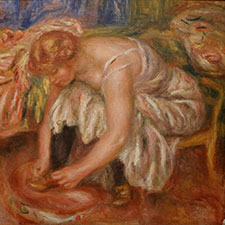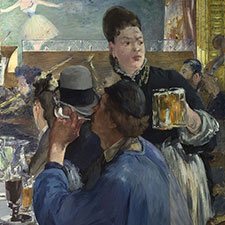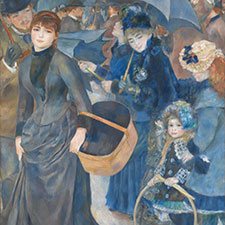Naples Yellow
Artificial inorganic pigmentComposition and Properties of Naples Yellow
Naples yellow is lead antimonate Pb2Sb2O7. Its composition may vary according to the method of preparation.

Pigment

Painted swatch
Names of Naples Yellow
Alternative names
Lead antimonate yellow, antimony yellow
Color Index
PY 41, CI 77588
Word origin
After the city of Naples.
Antimony: from Old French antimoine and directly from Medieval Latin antimonium, of obscure origin.
From Online Etymology Dictionary
Neapelgelb
German
Jaune de Naples
French
Giallo di Napoli
Italian
Amarillo de Nápoles
Spanish
Preparation of Naples Yellow
Naples yellow is one of the oldest synthetic pigments known to Man. It had been prepared by heating a mixture of any of the lead oxides with either antimony oxide Sb2O3 or some other antimony compound. The following is one of the recipes from the book by the Italian miniaturist Valerio Mariani da Pesaro from the beginning of the 17th century copied from an unknown original (2).
“You can also make this yellow of a fuller colour and more beautiful by taking 6 ounces of burnt lead and 4 ounces of antimony and one ounce of Afexandrine Tutty and I ounce of salt, and this all mixed together you grind it finely and put it on plates like the others, but vou heat it outside the furnace at the ventilation pipes and if by chance it will not get hot enough you will put if there again until it is done. But if it will come out too much cooked and if there is a fire and it is melted, then you will grind it finely again putting the material back on new plates, you will put it on a lower fire and if necessary one will repeat it several times and this way it will turn out beautifuly.”
Lead antimonate occurs naturally as the mineral bindheimite but the pigment had been produced synthetically.
Mineral Bindheimite

References
(1) Claudia Pelosi, Giorgia Agresti, Ulderico Santamaria, Elisabetta Mattei, Artificial Yellow Pigments: Production and Spectroscopic Characterization, e-PS, 2010, 7, 108-115
(2) Dik, J., Scientific analysis of historical paint and the implications for art history and art conservation. The case studies of naples yellow and discoloured smalt. Thesis, University of Amsterdam, 2003 (available as pdf).
(3) Henk Schenk, J. Dik, R. Peschar, The Production History of Naples Yellow and the Discoloration of the Blue Pigment Smalt, Acta Cryst. (2005). A61, C494
(4) L. Chiarantini1, F. Gallo, V. Rimondi, M. Benvenuti, P. Costagliola and A. Dini, Early Renaissance Production Recipes for Naples Yellow Pigment: A Mineralogical and Lead Isotope Study of Italian Majolica from Montelupo (Florence), Archeometry, 28 Nov 2014, DOI: 10.1111/arcm.12146.
(5) Robin J. H. Clark, Lucas Cridland, Benson M. Kariuki, Kenneth D. M. Harris and Robert Withnall, Synthesis, structural characterisation and Raman spectroscopy of the inorganic pigments lead tin yellow types I and II and lead antimonate yellow: their identification on medieval paintings and manuscripts. J. Chem. Soc., Dalton Trans., 1995, 2577-2582. DOI: 10.1039/DT9950002577.
(6) Joris Dik, E. Hermens, R Peschar, H Schenk, Early Production Recipes for Lead Antimonate Yellow in Italian Art, Archaeometry 08/2005; 47(3). DOI:10.1111/j.1475-4754.2005.00221.x. Available as pdf.
(7) Agresti G., Baraldi P., Pelosi C. and Santamaria U.,Yellow pigments based on lead, tin, and antimony: Ancient recipes, synthesis, characterization, and hue choice in artworks, Color Research and Application 41 (3) 2016. https://doi.org/10.1002/col.22026
History of Use
Naples yellow had been in use since antiquity until about 1850 (1). The following graph gives the frequency of its use in the paintings of the Schack Collection in the Bavarian State Art Collections in Munich (2).

References
(1) Kühn, H., Die Pigmente in den Gemälden der Schack-Galerie, in: Bayerische Staatsgemäldesammlungen (Ed.) Schack-Galerie (Gemäldekataloge Bd. II), München 1969.
Examples of use
Édouard Manet, Music in the Tuileries, 1862

9 Mustard-yellow coloured chairs in the foreground: Naples yellow (lead antimonate).

Identification
Fiber Optics Reflectance Spectra (FORS)
 Spectra by A. Cosentino, Cultural Heritage Science Open Source (CHSOS)
Spectra by A. Cosentino, Cultural Heritage Science Open Source (CHSOS)
Infrared Spectrum
1. IR Spectrum of in the ATR-FT-IR spectra of different pure inorganic pigments, University of Tartu, Estonia.
2. IR Spectrum pigment in linseed oil by S. Vahur, Database of ATR-IR spectra of materials related to paints and coatings, University of Tartu, Estonia
Raman Spectrum
Spectrum by Ian M. Bell, Robin J.H. Clark and Peter J. Gibbs, Raman Spectroscopic Library University College of London
X-Ray Fluorescence Spektrum (XRF)
XRF Spectrum in the Free XRF Spectroscopy Database of Pigments Checker, CHSOS website.
References
(1) O’Shea, M. L., A Historical and Chemical Analysis of the Artists’ Pigment Naples Yellow (Ph.D. Thesis), Reed College 1981
(2) Claudia Pelosi, Giorgia Agresti, Ulderico Santamaria, Elisabetta Mattei, Artificial Yellow Pigments: Production and Spectroscopic Characterization, e-PS, 2010, 7, 108-115
(3) Hradil, D., Grygar, T., Hradilová, J., Bezdička, P., Grűnwaldová, V., Fogaš, I., & Miliani, C. Microanalytical identification of Pb-Sb-Sn yellow pigment in historical European paintings and its differentiation from lead-tin and Naples yellows. Journal of Cultural Heritage, 8(4), 2007, 377–386. doi:10.1016/j.culher.2007.07.001
(4) Dik, J., Scientific analysis of historical paint and the implications for art history and art conservation. The case studies of Naples yellow and discoloured smalt. Thesis, University of Amsterdam, 2003 (available as pdf).
(5) Edwards H. Analytical Raman spectroscopic discrimination between yellow pigments of the Renaissance. Spectrochimica Acta 2011; 80: 14-20.

Microphotograph
image © Volker Emrath
Further Reading
References
(1) Wainwright, I.N.M., Taylor, J.M. and Harley, R.D. Lead Antimonate yellow, in Artists’ Pigments. A Handbook of Their History and Characteristics, Vol. 1: Feller, R.L. (Ed.) Oxford University Press 1986, p. 219 – 254. Available as pdf from the National Gallery of Art.
(2) Dik, J., Scientific analysis of historical paint and the implications for art history and art conservation. The case studies of Naples yellow and discoloured smalt. Thesis, University of Amsterdam, 2003 (available as pdf).
(3) O’Shea, M. L., A Historical and Chemical Analysis of the Artists’ Pigment Naples Yellow (Ph.D. Thesis), Reed College 1981.
(4) Claudia Pelosi, Giorgia Agresti, Ulderico Santamaria, Elisabetta Mattei, Artificial Yellow Pigments: Production and Spectroscopic Characterization, e-PS, 2010, 7, 108-115.
(5) Robin J. H. Clark, Lucas Cridland, Benson M. Kariuki, Kenneth D. M. Harris and Robert Withnall, Synthesis, structural characterization and Raman spectroscopy of the inorganic pigments lead-tin yellow types I and II and lead antimonate yellow: their identification on medieval paintings and manuscripts. J. Chem. Soc., Dalton Trans., 1995, 2577-2582. DOI: 10.1039/DT9950002577.
(6) S. Muntwyler, J. Lipscher, HP. Schneider, Das Farbenbuch, 2nd. Ed., 2023, alataverlag Elsau, pp. 82-83 and 360-367.










